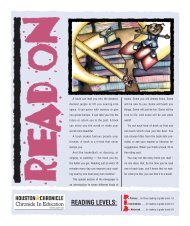Create successful ePaper yourself
Turn your PDF publications into a flip-book with our unique Google optimized e-Paper software.
11. Using the chalkboard, list “injured,” “blind,” and “mother.” Ask these special beavers<br />
how much food they collected. Write how much food they collected after each of<br />
their descriptions. Then, ask each of the other students how much food they found,<br />
writing each amount on the board. Tell the students now that each beaver needs 56<br />
pounds of food to survive for a week. Which beavers survived? Was their enough food<br />
for all the beavers? How many pounds did the blind beaver collect? What about the<br />
mother beaver? Was she able to collect 112 pounds? What will happen to her kits? Will<br />
she feed her kits first or herself? Why? What would happen to her if she fed the kits<br />
first? Why? What if she only fed herself? If the kits die, can she have more young in<br />
the future? (The mother beaver would feed herself first because of this fact. She<br />
must survive first if she is to hope for any of her young to survive.)<br />
12. If the water squares were included, each student should have picked up at least one<br />
square representing a water source. Otherwise, they do not survive. Water is essential to<br />
all life and is a key limiting factor. Specifically, for beavers, water is necessary for all<br />
components of their natural habitat: the river they swim in, the trees that grow on its<br />
well-watered banks, and the marshes that grow the beavers’ favorite aquatic plant foods.<br />
13. Ask each student to record how many pounds of each type of food gathered. Then,<br />
direct the student to convert these amounts to percentages (if they can). Provide the<br />
students with the background information on the typical diets of beavers (following the<br />
diet chart included and any biology sources you research) so that they can compare what<br />
they collected with the natural diet of beavers. How do beavers’ diets compare to<br />
humans’ diets? Maybe we should take a lesson from them and eat more veggies!<br />
14. Ask the students to arrive at a class total for all the pounds of food they gathered as<br />
beavers. Divide the total by 56lbs. needed for each beaver in order to survive one<br />
week (an approximation). How many beavers can Buffalo Bayou support? Why then did<br />
only ___ beavers survive? What percentage of beavers survived? What percentage<br />
would have survived had the food been evenly divided?<br />
15. Ask the students to calculate how many food squares must be added in order to<br />
support all of the beavers in the activity. If sufficient food were available for all the<br />
beavers, would the population likely increase or decrease? Other than food, what<br />
other factors, natural or human-caused, might also limit the growth of the beaver<br />
population in the bayou? How would each of these factors (food, water, space, shelter,<br />
pollution, etc.) affect the beaver population? Could the beaver population increase<br />
indefinitely if there were unlimited food? There are plenty of trees around the bayou<br />
aren’t there, so why don’t we see more beavers in Houston? What human-caused<br />
factors are hurting beaver populations here? Do you think Buffalo Bayou is important<br />
for beavers’ survival in our region?<br />
16. Now, introduce the important science term they have been learning about: the Limiting<br />
Factor. Based on their discussion, try as a group to define the term, limiting factor.<br />
Have the students discuss limiting factors for other animals, and even humans. Do we<br />
need to be concerned about having enough food and water for our own human<br />
populations? (Yes!)



